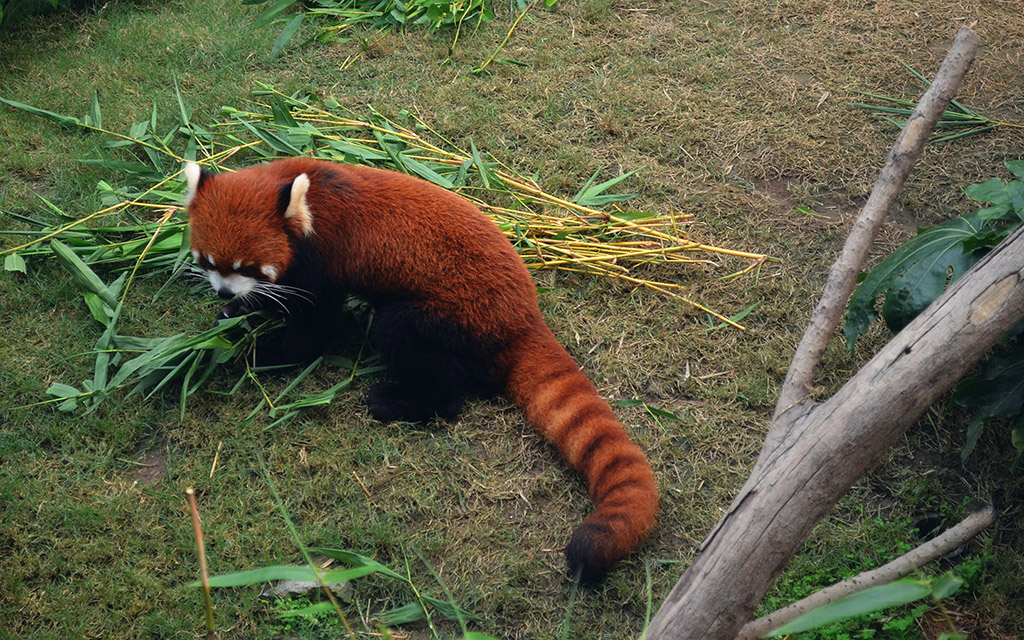KEEP RED PANDAS IN THE PINK

RED PANDA
Red pandas have their own special kind of red beauty. And while they are strikingly beautiful any time of year, they are particularly wonderful to see in autumn, when their russet red compliments the beautiful reds, oranges, and yellows of the season.
Red pandas are surprising in several ways. Firstly, they are not really pandas, nor are they closely related to the giant pandas we know and love. They have no close living relatives in the animal kingdom.
Red pandas are the only living member of the family Ailuridae, according to recent research. Molecular phylogenetic studies show that they are an ancient species in the order Carnivora, superfamily Musteloidea. Their nearest fossil ancestors, Parailurus, lived 3 to 4 million years ago. And because they are endangered, it is important that we take action help them live here on our planet for generations to come.
Red pandas do share some characteristics with giant pandas, however. They both eat bamboo and both are native to the high-elevation forests of Asia in northern Myanmar (Burma), Sichuan & Yunnan Provinces of China, Nepal, India, and Tibet.

Their beautiful red furry coats help to camouflage red pandas when they hang out in the canopy of fir trees whose branches are covered with clumps of reddish-brown moss and red lichens.
Long, coarse red guard hairs over a soft, dense, woolly undercoat, keeps red pandas warm in their typically cool habitats.

Red panda faces are mostly white, with reddish brown "tear tracks" extending from their eyes to the corners of their mouths, which help to reflect sunlight.

Long red and beige ringed bushy tails help red pandas to balance in the treetops.

Adult red pandas weigh between 8.2 and 13.7 pounds (3.7 to 6.2 kg). Their bodies are 22 to 24.6 inches (56 to 62.5 cm) long, with their tails adding another 14.6 to 18.6 inches (370 to 472 cm) in length. Males and females look the same.

Bamboo constitutes 85 to 95% of the red panda's diet. They eat only the most nutritious leaf tips and tender shoots, unlike giant pandas, which eat the whole bamboo plant.

Both giant and red pandas have special wrist bone which acts as an opposing thumb, helping them to grasp the bamboo stalks as eat. Red pandas also eat grasses, fallen fruits, insects, and grubs. Sometimes they eat birds and small mammals.

Red pandas breed from January through March in the Northern Hemisphere and in June-August in the Southern Hemisphere. Late spring births are timed so that their babies have access to the most tender and digestible new growth bamboo shoots and leaves. There are usually 2 cubs per litter.

Red pandas can live up to 22 years. However, they are endangered. The primary threats they face are habitat loss and degradation, human interference and poaching. Although they are legally protected in India, Bhutan, China, Nepal and Myanmar, they are still at risk. The total population of red pandas has declined by 50% over past 20 years and it is expected to continue.

Part of the difficulty in conserving red panda habitats is because these red furballs require a specific set of circumstances: proximity to water sources, good forest cover and altitude, and sufficient bamboo supplies.

The Smithsonian's National Zoo and Conservation Biology Institute have been at the forefront of red panda conservation, developing new reproductive technologies to preserve sperm and egg DNA for future breeding and reintroduction to the wild programs. More than 100 surviving cubs have been born here since 1962. Help support them here.

The Red Panda Network is a community-based effort that partners with local non-profits and community organizations in important red panda conservation programs. Help support them here.

The Wildlife Conservation Society saves wildlife and wild places worldwide through science, conservation action, education, and inspiring people to value nature. There are red pandas at several of the parks in New York City that WCS manages, including the Bronx Zoo, Prospect Park Zoo, and Central Park Zoo. Help support them here.

Read more about Beautiful Reds all this week on BeautifulNow. And check out more beautiful things happening now in BN Wellness, Impact, Nature/Science, Food, Arts/Design, and Travel, Daily Fix posts.


Do you have amazing photos? Enter them in this week’s BN Photo Competition.


